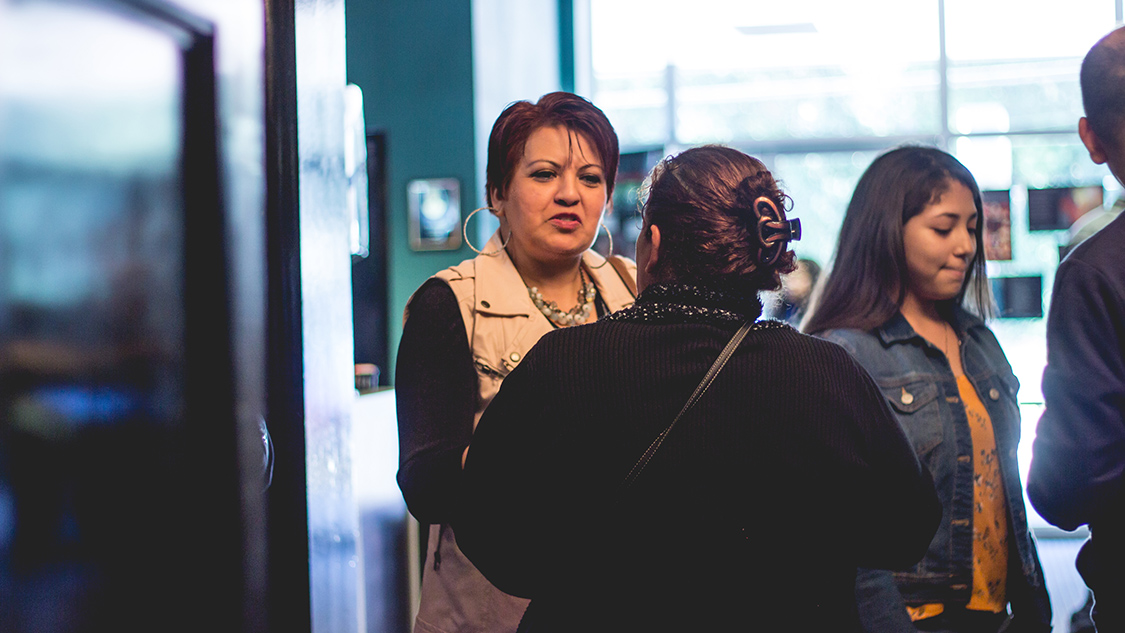
An interview with Tom Haren
Tom Haren oversees the care ministry at NewSpring Church at its Anderson, SC, campus. He shared with us how NewSpring uses trained volunteers to minister to people who respond to the invitation or challenge following worship services. Caring for people at a growing church can be a real challenge, but we hope this approach stimulates you to think in a fresh way how you care for the members of your church.
What led NewSpring to develop its care ministry teams for after worship services?
We officially launched the care team toward the end of 2001. Up to that point, we had a couple hundred people. We’d always done invitations at the end of sermons, and we might have a handful of people come back in response to the sermon. However, people just wandered around, not knowing where to go or what to do. So, a light bulb went off for my predecessor, Jake, and he assumed the role of a “care pastor” at that point in time. He thought, “We have incredible volunteers—people who are really wise in the Word and who really want to help others. Let’s get them connected to people who are broken, and hurting, and who need help.” In the beginning we had some interesting team names thrown around. We initially named our care team the “Barnabas Team.” But nobody knew what that meant!
We kept that name until 2004, I believe, and then it became simply “the Care Team.”
Our Care Team is part of the ministry area we call “Next Steps”—programs related to discipleship and spiritual formation. Our greatest desire is for our care volunteers to point people to Jesus. For me, that’s on both sides of the Cross. If we give a person a whole bunch of practical steps, but he or she hasn’t met Christ yet, then we’re probably just spinning our wheels. So we try to share the gospel in every conversation.
Now, we realize that salvation belongs to the Lord, so we can’t strong-arm anyone or force them into a confession of faith, but we’re going to make sure that we have the conversation. They may tell us, “I’m not ready for that. That’s not why I’m here.” Then, we’ll get a little more practical at that point.
The same thing holds true for people on the other side of the Cross (believers). Christians can step away from the Lord and adopt a lifestyle inconsistent with what the Scriptures teach. They need reminding that Christ is the focal point. He’s the cornerstone and the centerpiece of everything in the Christian life.
We’ve come to realize that people usually can handle about one “next step” (of change) in their lives at a time. So our care volunteers assist people by recommending a next step; then the volunteers follow up with them during the week and ask how they can help them take that next step.
How does NewSpring organize the volunteer care ministry teams for Sundays?
Currently we have worship services at 9:15 a.m., 11:15 a.m., and 5:00 p.m. After the service leader communicates in the larger huddle with the Care Team, the volunteers break off into smaller “team connector groups” of four or five people (both male groups and female groups) for prayer and encouragement prior to their Sunday service.1
The initial contact
Whoever is teaching on a Sunday will initiate a time of response/invitation at the end of the message. That’s when our care volunteers get started. They have green lanyards to indicate they’re on the Care Team. They will reach out to folks as they respond to the invitation.
A care volunteer (say, “Mike”) will lock eyes with a person who is responding to the invitation and say, “Hello. My name’s Mike from the Care Team. I’d love to chat with you today.” Then, Mike will escort the person (say, “John”) through our atrium and into our care room. There, Mike and John will have a conversation that usually runs twenty or thirty minutes.
The care conversation is intended to encourage John, to share some biblical truth with him, and to pray with him. During that conversation, Mike will fill out a “Next Steps Card,”
which includes John’s name, a summary of their conversation, and a little perforated tear-off section at the bottom that has Mike’s contact information, so John can get in touch with him throughout the week. The Next Steps Card gets turned in at the care desk.
The first follow-up
Right after the care conversation, Mike writes John an encouraging note and leaves it at the care desk. We put postage on it, and it will land in John’s mailbox on Monday or Tuesday. The person who receives the note feels very encouraged, which makes contact with the church feel very personal.
The “next step”
An office team enters the Next Steps Cards on Mondays and inputs that data into our database.The information is automatically sent to the care volunteer’s email for follow-up purposes. The email says something like, “Hey, Mike, thank you for having a conversation with John this week. As a reminder, John’s number is ____ and his email is ____. Here are your conversation notes. We’d love for you to follow up with John within 48 hours.”
Later in the week Mike gives John a call: “Hey, John, remember we talked about ____ on Sunday?” Mike has been trained to follow up with John and be actively involved in the next steps on his spiritual journey. Maybe that will be a baptism this coming Sunday, and Mike will be available to cheer John on. Maybe John wants to get connected to a serving team or another group in our church. Whatever it is, Mike’s going to keep walking with him and be a friend to him.
How does NewSpring handle people who need counseling or other assistance?
We want to help people take the next step that will help them the most, but sometimes that requires help outside our congregation. Let’s say John’s marriage has been deteriorating for a few years, and now he’s bringing this up to Mike. Mike would know this is not going to be just a twenty- or thirty-minute conversation. Mike would make sure John receives a Christian counselor referral list available in the care room and continue the follow-up process until he knows for certain that John has started the marital counseling.
How does NewSpring prepare people to serve on the care ministry team?
Training is a really important part of our team. If our volunteers aren’t adequately prepared, then we’re not positioning them to care for others. Furthermore, we may look for people who are a little more mature in their faith and have walked a bit longer with the Lord so that they are adequately positioned to utilize the primary gifts God has given them. This may involve a progression from one serving area to the care room, when they feel ready.
The first stage of training
We have a three- to four-week orientation process onto our team. It begins with a 50,000-foot “aerial” view of what all of our Next Steps Ministry looks like, and then it progressively narrows to a very specific role in the ministry. This process includes an interview with a volunteer who is trained to make sure it is a good fit for the new volunteer and that there are no red flags. This process also includes hypothetical care situations and will continue till an observed real-life care conversation takes place. The person training the new volunteer will provide coaching and feedback upon the conclusion of this conversation.
The second stage of training
Let’s get back to our friend John. Once he chooses the best worship service for him and his family, he will be assigned a Team Connector Group Leader. Also, at this point, we work really hard in his continued training. We communicate with our volunteers weekly via email. We have the huddle times prior to each service. Here, our service leaders gather together their volunteers and talk about the service vision for the day, the invitation that will be issued, and any specific training that might be needed for the day. Then they pray together.
The third stage of training
But there’s more to training and equipping our volunteers. We have larger get-togethers quarterly. The quarterly training is based on the trends that we’re seeing from the care conversations and the direction that we’re going as a church. Our leaders do a great job of planning ahead, so we know what topics are coming down the road. In these quarterly meetings we try to blend all that together and give our care volunteers some “in season” training so that they’re equipped to do the role that we’ve asked them to do.
Because of the multitude of care issues we hear about—anything from “I’m having a rough week” to “I’m ready to commit suicide”—we can’t train volunteers for every possible scenario they might encounter. So we consistently train according to a “90 percent rule”—train and equip volunteers regularly for the things that they’ll see most often. For the 10 percent of conversations that are extreme care situations, we’ve trained volunteers to utilize the staff or their service leaders in those types of conversations. We want them to know that they are never alone or in over their heads!
Questions for you: What can you learn from this model?
Having learned that NewSpring uses volunteers to help people after their worship services, you might consider these questions as you think about a care ministry for people after your worship services:
- What does pastoral care look like in your church now? Is it intentional and planned—or is it more spontaneous? Do you see value in incorporating a care team approach similar to NewSpring’s?
- If you were to implement a care ministry program following worship services, is there a place in your facility where private conversations could be held?
- Among the more spiritually mature people in your church, who tends to reach out to hurting people—or who tends to be a person others like to talk to?
- Since this type of ministry occurs directly after a worship service, time for it is not likely going to be a great obstacle. But, how might the ongoing training be incorporated into the church’s schedule?2
- Could you or someone else in your congregation possibly take a leadership role in this type of ministry?
- Even if you think a care team ministry after worship services is intriguing, you might have questions or concerns. When could you discuss them with others on your leadership team?
Footnotes:
- Also, each team connector group has a leader, and that person is responsible for following up with his or her group weekly and making sure they are doing OK. This ensures the health of our volunteers, which is vital to ensuring the health of our church.
- If you need suggestions for possible training resources, you might consider Paul David Tripp, Instruments in the Redeemer’s Hands (Phillipsburg, NJ: P & R Publishing, 2002); Timothy S. Lane and Paul David Tripp, How People Change (Greensboro, NC: New Growth Press, 2006); Edward T. Welch, Side by Side: Walking with Others in Wisdom and Love (Wheaton, IL: Crossway, 2015); Bob Kellemen and Kevin Carson, eds., Biblical Counseling and the Church (Grand Rapids: Zondervan, 2015).
